 Oral cavity and gingiva, in particular, are a very vulnerable part of the child's body, as they are constantly subjected to physiological changes.
Oral cavity and gingiva, in particular, are a very vulnerable part of the child's body, as they are constantly subjected to physiological changes.
These include teething, hormonal fluctuations, replacement of dairy products with permanent ones.
Normally, the gums in children have a pale pink color, they are very tender and easily injured, but at the same time reflect the condition of the whole organism. If there are problems with the gums, then, perhaps, it is worth looking for the development of pathology in other organs.
Contents
- Possible gum disease in children
- Inflammatory diseases of the oral cavity
- Dystrophic diseases
- Causes of the inflammatory process
- Local factors
- Common causes
- The main symptoms of the development of inflammation
- Methods of therapy - how to ease the baby's condition?
- Plaque removal
- Anti-inflammatory therapy
- Folk methods of treatment
- Features of treatment for children under 1 year
- Remember and comply not to suffer
- Oral sanitation
- Teaching the child hygiene rules
- Recommendations on nutrition
Possible gum disease in children
Diseases that are more frequentall affect the oral cavity of the child, are divided into two groups:
- inflammatory;
- dystrophic.
Inflammatory diseases of the oral cavity
To this group of diseases that occur in childhood, include the following:
- Gingivitis - inflammation of the gums. It is characterized by bleeding during eating or brushing your teeth, you can visually notice the redness and swelling of the gingival papillae. Necessarily requires treatment in the early stages, otherwise it can develop into a more serious pathology.
- Periodontitis .Inflammatory disease of the peri-toothed tissues that surround and hold the tooth in the jaw. Between the gum and the root of the tooth, a pocket is formed in which dental plaque and microbes accumulate. This leads to gum disease and loosening of the teeth. Periodontitis is characterized by a transition to a chronic form, and this significantly reduces the chances of a full recovery.
- Gingivostomatitis is classified as an infectious inflammatory disease. The reason is the development of pathogenic microflora in the oral cavity. Gums form on the gums, they bleed, the body temperature rises, painful sensations increase.
- Periodontitis is also an inflammatory disease that affects the root membrane of the tooth and the connective tissue surrounding it. May be infectious or develop as a result of trauma.

In the picture examples of manifestations of gingivitis in children
Dystrophic diseases
This category includes such diseases:
- Atrophy of the gingival tissue .It arises due to the formation of an incorrect bite, crowding of teeth, getting some kind of injuries, incorrect treatment of other problems of the oral cavity. Painful sensations, as a rule, do not exist, but atrophic phenomena cause the denudation of the root and neck of the tooth, which leads to the development of hypersensitivity.
- Parodontosis - atrophy of all periodontal tissues up to resorption of bones. This pathology is extremely rare and only in children with severe concomitant diagnoses, beriberi and immune suppression. This process is irreversible. Treatment consists in removing the affected tooth.
Causes of the development of the inflammatory process
To lead to the development of gum disease in children can a lot of factors that are conventionally divided according to the nature of the action on local and general.
Local factors
These include:
- The main reason is the congestion of microorganisms .This is due to improper or insufficient brushing of teeth, non-compliance with oral hygiene. As a result, accumulates a soft plaque, which eventually turns into tartar. The latter also causes the development of gingivitis in children.
-
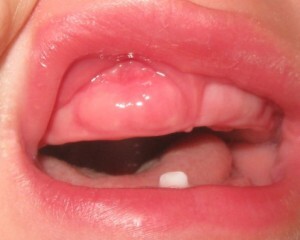 injuries of gum tissue can also provoke such problems: scratches, burns, cuts, chemical effects.
injuries of gum tissue can also provoke such problems: scratches, burns, cuts, chemical effects. - The cause of dystrophic and inflammatory diseases of gums in children may be teething , as this process often leads to gingivitis.
- may be a trigger for developing such pathologies, as well as an abnormal bite, an anatomically short frenum of the tongue and lips, a habit of chewing food only on one side.
Common causes of
To this group of causes include the disease of any organs and systems:
- respiratory;
- of the digestive tract;
- cardiovascular;
- Immune
- hormonal adjustment;
- deep hypo- or avitaminosis;
- is an autoimmune or allergic disease.
The main symptoms of the development of inflammation
In the event of any gum disease the child will be disturbed by the following symptoms:
- burning and itching in the gums;
- bad breath;
- edema, swelling, reddening of the gingival tissues, their bleeding;
- pain in the teeth, yellow plaque, increased sensitivity to cold or hot stimuli;
- presence of a cyst on the jaw;
- increased looseness of gingival tissues;
- redness or atrophy of the papillae;
- Nude neck or root of tooth.
Methods of therapy - how to relieve the condition of the baby?
When to avoid inflammatory diseases of gums it is not possible, it is necessary to start immediate treatment. You can cope with this problem by applying a set of therapeutic measures. You will need to get rid of the plaque, take a course of taking anti-inflammatory drugs.
Plaque removal
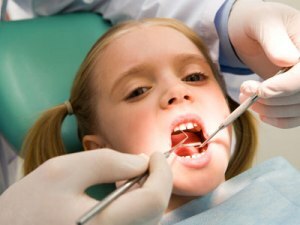 Plaque deposition on the teeth can be observed if the hygiene rules of the oral cavity are not observed or if there is insufficient purification.
Plaque deposition on the teeth can be observed if the hygiene rules of the oral cavity are not observed or if there is insufficient purification.
At first it is soft, but eventually becomes mineralized and turns into a solid one. Such a plaque can not be removed with a conventional toothbrush.
But this must be done, as it can cause the development of an inflammatory process in the gingival tissues.
You can go through this procedure at the dentist. The plaque is removed by means of polishing brushes with a special ultrasonic device. Manipulation is painless. It should not only be performed if there are problems with the gums, but also as prevention. Then the health of the mouth will be ensured.
Anti-inflammatory therapy
To get rid of such symptoms as pain, bleeding gums, hyperemia, swelling, which are worrisome for gingivitis in children, it is necessary to prescribe the use of anti-inflammatory drugs. The most frequently used applications and mouth rinses with antiseptic solutions.
Of the latest most common and effective are:
-
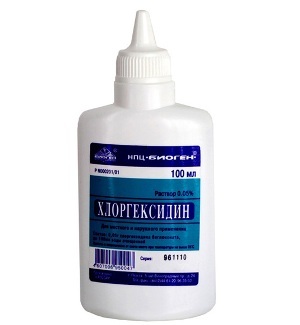 Miramistin .Use it is allowed to children from the age of three. Rinse should be at least 3-4 times a day, the duration of each not less than 30 seconds.
Miramistin .Use it is allowed to children from the age of three. Rinse should be at least 3-4 times a day, the duration of each not less than 30 seconds. - Water infusions and decoctions of herbs , which have an anti-inflammatory effect. For example, chamomile, eucalyptus, sage.
- Chlorhexidine .Apply rinsing with this solution is necessary in the morning and in the evening, the duration of the procedure is half a minute. This tool can be used for children of any age. The course should not exceed 10 days.
It will be good if after rinsing you fix the result with anti-inflammatory ointments or gel. They are applied to the gum or her papilla. Here are a few of them:
- Metragyl Denta .It is applied to the affected areas of gums twice a day. After using it for 2 hours you should not eat, drink. The use of the drug is indicated for children older than 6 years.
-
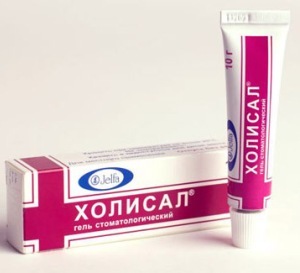 Holisal - gel for gums with anti-inflammatory and analgesic effect. This effect is due to choline salicylate and cetalkonium chloride, which are part of the drug. This feature makes it possible to use it not only for inflammatory processes of the oral cavity, but for teething. Restrictions in the age of the drug does not. Use the gel twice a day after treatment of the oral cavity with antiseptics. For 2 hours after use, rinses and meals are prohibited.
Holisal - gel for gums with anti-inflammatory and analgesic effect. This effect is due to choline salicylate and cetalkonium chloride, which are part of the drug. This feature makes it possible to use it not only for inflammatory processes of the oral cavity, but for teething. Restrictions in the age of the drug does not. Use the gel twice a day after treatment of the oral cavity with antiseptics. For 2 hours after use, rinses and meals are prohibited.
Folk methods of treatment
To get rid of inflammation of the oral cavity it is possible using:
- Essential oils .They well strengthen the gums, freshen breath. You will need a piece of gauze or bandage, fold it into several layers and soak with fir, peach or sea-buckthorn oil. Then apply this napkin to the gum for 10 minutes. Do this procedure need a week and a half.
-
 Lipa also perfectly removes the symptoms of gum inflammation in children. It is necessary to mix its flowers with bark of an oak and water in the ratio 2: 1: 5.The resulting mixture is boiled for an hour, then placed in a dark place for cooling. The resulting broth is used to rinse every morning and evening.
Lipa also perfectly removes the symptoms of gum inflammation in children. It is necessary to mix its flowers with bark of an oak and water in the ratio 2: 1: 5.The resulting mixture is boiled for an hour, then placed in a dark place for cooling. The resulting broth is used to rinse every morning and evening. - Inflammatory processes with purulent manifestations can be eliminated with natural of dark honey .1 teaspoon should be chewed for about 10 minutes.
Features of treating children under 1 year old
 Young children often take their fingers, toys and other objects in their surroundings. This can cause penetration of microorganisms and the development of inflammation of the gums. At the age of 1 year, gingivitis and gingiva stomatitis are common.
Young children often take their fingers, toys and other objects in their surroundings. This can cause penetration of microorganisms and the development of inflammation of the gums. At the age of 1 year, gingivitis and gingiva stomatitis are common.
To get rid of this problem, you first need to ensure the cleanliness of surrounding objects.
The food that the baby feeds should be warm, not acidic and not salty. After each meal, the oral cavity should be treated with antiseptic solutions:
- Furacilin ( 1t per 0.5 cup of water);
- Chlorhexidine ( 0.05% aqueous solution);
- soda solution ( 1 tea-spoon for a glass of water).
For the doctor's prescription, special anti-inflammatory creams or gels are used. In severe cases, physiotherapeutic procedures are prescribed.
Remember and comply so as not to suffer
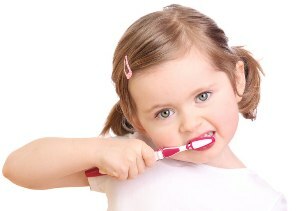 To prevent the development of inflammatory diseases of the gums is always easier than getting rid of them.
To prevent the development of inflammatory diseases of the gums is always easier than getting rid of them.
To prevent such problems from affecting your baby, follow simple preventive measures that consist of oral sanitation, training in personal hygiene and proper diet.
Oral sanitation
This procedure consists in carrying out a routine examination of the oral cavity by a dentist. It allows you to identify possible problems in the early stages and immediately begin treatment.
It's enough for a healthy child to undergo this procedure once a year. If there are any deviations, the regime of visiting the dentist is appointed individually by the treating doctor.
Teaching the child the rules of hygiene
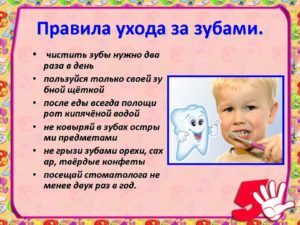 This stage is one of the most important. It is necessary to teach a child to brush his teeth regularly from the moment of cutting the first tooth.
This stage is one of the most important. It is necessary to teach a child to brush his teeth regularly from the moment of cutting the first tooth.
It is important to teach him how to properly wield a toothbrush. Carry out procedure in the morning and in the evening.
To brush your teeth, the baby should enjoy the brush, he should like the brush, and toothpaste should have a pleasant taste.
For the smallest, it is worth choosing a toothbrush with a bristle in two rows and a long handle, the head should be narrow.
Recommendations for nutrition
Proper nutrition also affects the health of the oral cavity. To prevent inflammatory diseases, teach children not to snack between the main meals. In addition, it is necessary to limit the use of sweets, carbonated drinks. They can be given to the child only after eating, and then you need to brush your teeth.
Children under 1 year should not be offered at night and to fall asleep a bottle with sweet compote, juice or a mixture. This can lead to the development of caries, gingivitis, incorrectly formed bite.
